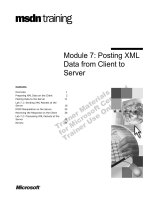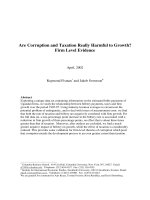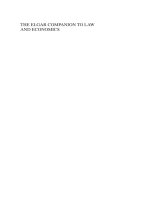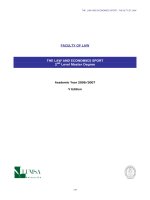Law and Economics From Lighthouses to Software docx
Bạn đang xem bản rút gọn của tài liệu. Xem và tải ngay bản đầy đủ của tài liệu tại đây (183.11 KB, 45 trang )
1
Law and Economics
From Lighthouses to Software
Matthias Bärwolff
Wintersemester 2005/2006
2
The Ideal World
3
No transaction costs
Perfect information
Full rationality
4
Excursus: Coase Theorem
“In a world of zero transaction costs an efficient
allocation of resource will ensue regardless of the
initial distribution of resources.“
The formalisation of the Coase Theorem ows largely to George J. Stigler (1966). The
Theory of Price, 3
rd
edition, New York: Macmillan
5
The Unfortunate Reality
6
Transaction costs
Imperfect information
Bounded rationality
7
Externalities
8
„[O]ne person A, in the course of rendering some
service, for which payment is made, to a second
person B, incidentally also renders services or
disservices to other persons [ ], of such a sort
that payment cannot be exacted from the
benefited parties or compensation enforced on
behalf of the injured parties.“
(Pigou 1932)
A. C. Pigou (1932). The Economics of Welfare. 4
th
edition. London: Macmillan.
9
10
The Lighthouse
„A businessman could not build it for a profit,
since he cannot claim a price from each user.“
(Samuelson 1964)
P.A. Samuelson(1964). Economics: An introductory Analysis. 6
th
edition. New York:
McGraw-Hill.
11
The Solution
„It is possible for the State [ ] to remove the
divergence [between private and social net
product through] bounties and taxes.“
(Pigou 1932)
A. C. Pigou (1932). The Economics of Welfare. 4
th
edition. London: Macmillan.
12
?
13
The Problem
State
Production Consumption
14
The State as a „Super-Firm“
„The government is [ ] a super-firm. [ ]
But the ordinary firm is subject to [relatively
efficient] checks in its operation [which the
government is not].“
(Coase 1960)
R. A. Coase (1960). The problem of social cost, Journal of Law and Economics 3, 1-
44. [Reprinted 1990 in The Firm, the Market and the Law, Chicago: University of
Chicago Press.]
15
Public Choice
Politicians are selfish
Bureaucrats are selfish
Voters are selfish
Lobby groups have a disproportionate influence
Buchanan, James M., and Gordon Tullock (1962). The Calculus of Consent: Logical
Foundations of Constitutional Democracy. Ann Arbor: University of Michigan
Press.
16
Firm instead of Market
“A firm [may emerge] to deal with the problem of
harmful effects [ ] whenever the administrative
costs of the firm were less than the market
transactions that it supersedes.“
(Coase 1960)
R. A. Coase (1960). The problem of social cost, Journal of Law and Economics 3, 1-
44. [Reprinted 1990 in The Firm, the Market and the Law, Chicago: University of
Chicago Press.]
17
Market, Firm, or Nothing At All
“A further alternative [ ] is to do nothing about
the problem at all.“
(Coase 1960)
R. A. Coase (1960). The problem of social cost, Journal of Law and Economics 3, 1-
44. [Reprinted 1990 in The Firm, the Market and the Law, Chicago: University of
Chicago Press.]
18
The Lighthouse Revised
“[T]he building of lighthouses had been taken
over by private individuals.
[They presented] a petition from shipowners and
shippers in which they said that they would
greatly benefit from the lighthouse and were
willing to pay the toll.“
(Coase 1974)
R. A. Coase (1974). The Lighthouse in Economics. Journal of Law and Economics 17
(October): 357-76. [Reprinted 1990 in The Firm, the Market and the Law,
Chicago: University of Chicago Press.]
19
The Lighthouse Revised
“The tolls were collected at ports by agents [ ]
who [ ] were commonly custom officials.“
(Coase 1974)
R. A. Coase (1974). The Lighthouse in Economics. Journal of Law and Economics 17
(October): 357-76. [Reprinted 1990 in The Firm, the Market and the Law,
Chicago: University of Chicago Press.]
20
The Lesson
“Look twice!“
21
How to aid bringing about
market results?
22
The Courts
“[T]he courts have often recognized the economic
implications of their decisions and are aware (as
many economists are not) of the reciprocal nature
of the problem.“
(Coase 1960)
R. A. Coase (1960). The problem of social cost, Journal of Law and Economics 3, 1-
44. [Reprinted 1990 in The Firm, the Market and the Law, Chicago: University of
Chicago Press.]
23
The Courts
“It seems probable that in the interpretation of
words and phrases like 'reasonable' [begründet,
zumutbar] or 'common or ordinary use'
[ortsüblich] there is some recognition [ ] of the
economic aspects of the question at issue.“
(Coase 1960)
R. A. Coase (1960). The problem of social cost, Journal of Law and Economics 3, 1-
44. [Reprinted 1990 in The Firm, the Market and the Law, Chicago: University of
Chicago Press.]
24
The Common Law Efficiency Thesis
“In settings where the cost of allocating resources
by voluntary transactions is prohibitively high [ ]
the common law prices behavior in such a way as
to mimic the market.“
(Posner 1992)
Richard A. Posner (1992). Economic Analysis of Law. 4
th
edition. Boston: Little, Brown
and Co.
25
Principal Limitations
Common Law
v
Civil Law









